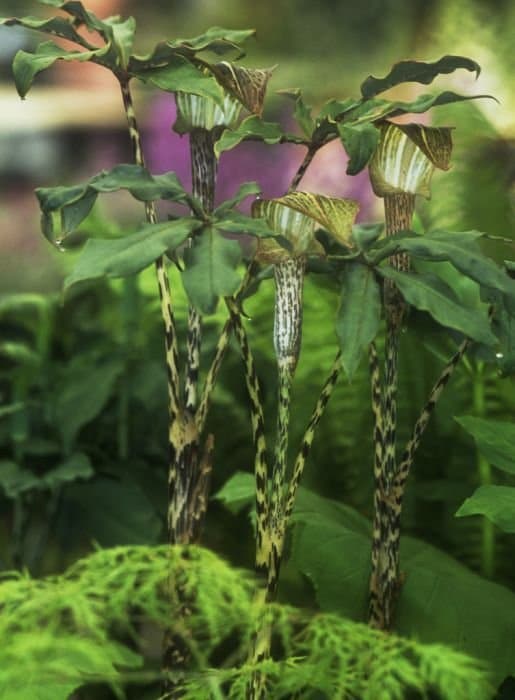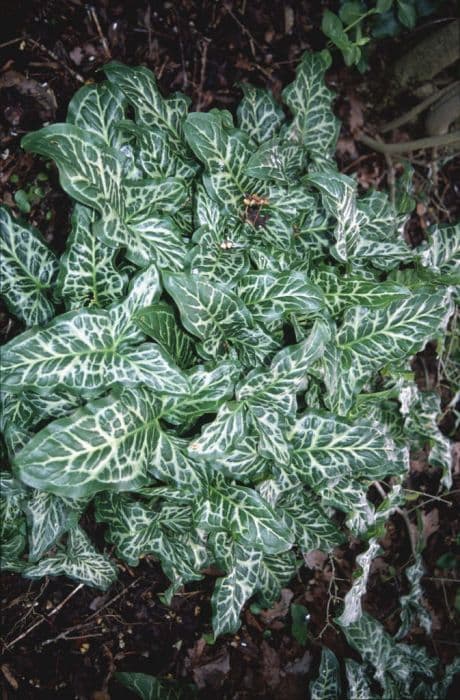Calla Lily 'Nashville' Zantedeschia 'Nashville' (PBR)

ABOUT
Zantedeschia 'Nashville', commonly known as the Calla Lily 'Nashville', is an elegant and striking perennial known for its distinctive floral attributes. The plant produces glossy, arrow-shaped leaves that are rich green in color, creating a lush backdrop for the flowers. The spathe—a large, flaring, trumpet-like bract that is often mistaken for a petal—wraps around the central spike known as the spadix in a graceful curve, and is typically a deep and vibrant shade that can range from pinks to purples, depending on the lighting and environment. The true flowers are small and sit along the spadix. The spadix itself is a prominent feature that contrasts with the spathe in hue and texture, often being a shade that sets off the spathe’s color beautifully. This combination of spathe and spadix creates a sophisticated look that is often used in floral arrangements and highly sought after by gardeners for its showy display. The Calla Lily 'Nashville' blooms with a sophistication that is characteristic of the breed, exuding subtle beauty without being overbearing. When in bloom, the flowers provide a captivating focal point, drawing attention with their unique shape and striking coloration. The glossy foliage often carries on the allure of the plant even when it is not in flower, contributing a full-bodied, verdant presence in the garden or as part of an indoor display.
About this plant
 Names
NamesFamily
Araceae
Synonyms
Calla Lily, Arum Lily.
Common names
Zantedeschia 'Nashville' (PBR).
 Toxicity
ToxicityTo humans
Zantedeschia 'Nashville' is commonly known as Calla Lily. Calla Lily is toxic to humans when ingested due to the presence of calcium oxalate crystals. These crystals can cause tissue irritation, leading to symptoms such as burning and swelling of the lips, mouth, and throat, excessive drooling, difficulty swallowing, and possible upset stomach, vomiting, or diarrhea if ingested in significant quantities. Handling the plant may also cause skin irritation in sensitive individuals.
To pets
Calla Lily is toxic to pets as well. Ingestion can lead to symptoms such as oral irritation, drooling, vomiting, difficulty swallowing, and even potential swelling of the throat, which could lead to breathing difficulties. The presence of calcium oxalate crystals is responsible for the toxic effects seen in pets, similar to the reaction in humans. All parts of the plant contain these crystals and therefore pose a risk if ingested by animals.
 Characteristics
CharacteristicsLife cycle
Perennials
Foliage type
Deciduous
Color of leaves
Green
Flower color
Cream
Height
1-2 feet (30-60 cm)
Spread
1-2 feet (30-60 cm)
Plant type
Herb
Hardiness zones
8
Native area
South Africa
Benefits
 General Benefits
General Benefits- Decorative appeal: The Calla Lily, known for its elegant and sculptural flowers, adds a touch of sophistication to gardens and indoor spaces.
- Versatility in landscaping: Calla Lilies can be grown in borders, containers, or as cut flowers in floral arrangements.
- Range of colors: 'Nashville' offers unique flower colors which can complement various garden color schemes.
- Attracts pollinators: It can attract beneficial insects like butterflies and bees, promoting biodiversity.
- Easy to grow: This plant is relatively easy to care for, making it suitable for novice gardeners.
- Perennial growth: As a perennial, it will return year after year under the right climate conditions, providing long-term value.
- Drought resistance: Once established, Calla Lilies can tolerate periods of drought, reducing the need for constant watering.
 Medical Properties
Medical PropertiesThis plant is not used for medical purposes.
 Air-purifying Qualities
Air-purifying QualitiesThis plant is not specifically known for air purifying qualities.
 Other Uses
Other Uses- Zantedeschia, commonly known as calla lily, can be used in floral art and design classes to teach students about flower anatomy, as its distinctive structure is ideal for educational purposes.
- Due to their elegant shape, calla lilies are often used in photography workshops and still life paintings for practicing composition and lighting techniques.
- Calla lilies can be used as natural indicators of the growing season when planted in a garden, as they bloom in the late spring to early summer.
- They can serve as a living palette for artists testing color mixtures, as their white flowers provide a natural backdrop for watercolor or other paint mediums.
- When planted in mass, calla lilies can act as a privacy screen in gardens due to their height and foliage, offering a beautiful and natural way to delineate spaces.
- Calla lilies can be included in science fair projects that explore the effects of colored light on plant growth, as their distinct flowering can be an interesting subject of the study.
- The flowers can be used in workshops on natural dyeing techniques, as their pigments can provide subtle hues to fabrics.
- Calla Lilies are often used as a natural pest deterrent, where the plants serve as a trap crop for certain insects, protecting other nearby plants.
- In culinary classes, the non-toxic varieties of calla lilies can occasionally be used as an exotic garnish for plating, emphasizing presentation skills.
- The sturdy stems of calla lilies make them ideal for crafting homemade paper flowers or as molds for clay and plaster art projects.
Interesting Facts
 Feng Shui
Feng ShuiThe Calla Lily is not used in Feng Shui practice.
 Zodiac Sign Compitability
Zodiac Sign CompitabilityThe Calla Lily is not used in astrology practice.
 Plant Symbolism
Plant Symbolism- Purity: The Zantedeschia 'Nashville', commonly known as Calla Lily, often symbolizes purity due to its clean, trumpet-shaped blooms that are frequently used in wedding bouquets.
- Beauty: The elegant form and often white color of the Calla Lily represent beauty and grace, making them a popular choice in floral arrangements.
- Femininity: With its delicate structure, the Calla Lily is often associated with femininity and the divine beauty of a woman.
- Resurrection and rebirth: Some cultures view the Calla Lily as a symbol of Jesus's resurrection due to its trumpet shape, indicating victory over death. It can also denote new beginnings and rebirth.
- Overcoming challenges: The Calla Lily's ability to bloom and thrive in a variety of conditions is sometimes seen as a metaphor for overcoming challenges and adversity.
- Devotion: The long-lasting nature of the Calla Lily flower is often seen as representing faithfulness and undying devotion in relationships.
 Water
WaterCalla lilies, such as the Zantedeschia 'Nashville,' should be watered thoroughly and then allowed to dry out slightly between waterings. Typically, water when the top inch of soil feels dry, which may translate to watering once every 7 to 10 days, depending on environmental conditions. Use around one quart of water for smaller pots, and up to 1-2 gallons for larger containers, ensuring you water enough to moisten the soil all the way through but not to the point of saturation. Never let the plant sit in water as it can cause root rot. It's best to water in the morning to allow excess moisture to evaporate throughout the day.
 Light
LightCalla lilies, including the Zantedeschia 'Nashville,' thrive in bright, indirect sunlight. The ideal spot for this plant is a location where it can receive dappled sunlight or bright shade without being exposed to harsh midday sun. East or west-facing windows are generally a good fit, as they provide bright light without the scorching intensity of direct southern exposure.
 Temperature
TemperatureCalla lilies, like Zantedeschia 'Nashville,' prefer temperatures between 60 and 75 degrees Fahrenheit. They can tolerate a minimum temperature of about 50 degrees Fahrenheit and a maximum of around 80 degrees Fahrenheit. The ideal temperature helps ensure vigorous growth and bloom. Avoid placing the plant in drafty areas or near heat sources that can cause temperature fluctuations.
 Pruning
PruningPrune Calla lilies, like Zantedeschia 'Nashville,' to remove spent flowers and any yellowing leaves to keep the plant looking tidy and direct energy to new growth. Pruning is also done to control the shape and size of the plant. The best time for pruning is after blooming, when you can deadhead the flowers and trim back any excess growth. Pruning can be done every few weeks during the growing season as necessary.
 Cleaning
CleaningAs needed
 Soil
SoilCalla Lily 'Nashville' requires a well-draining soil mix with a pH of around 5.5 to 6.5. A mixture containing peat, perlite, and potting soil is ideal for ensuring proper drainage while retaining enough moisture to nurture the plant's rhizomes.
 Repotting
RepottingCalla Lily 'Nashville' should be repotted every couple of years or when it becomes root-bound. The best time to repot is after the dormancy period, just before the new growth starts in the spring.
 Humidity & Misting
Humidity & MistingCalla Lily 'Nashville' thrives best at a moderate humidity level, typically around 60-70%. Maintaining consistent humidity will promote lush growth and vibrant blooms.
 Suitable locations
Suitable locationsIndoor
Position in bright, indirect light; keep the soil evenly moist.
Outdoor
Plant in partial shade, keep moist in fertile, well-drained soil.
Hardiness zone
8-10 USDA
 Life cycle
Life cycleThe Zantedeschia 'Nashville' (PBR), commonly known as the Nashville Calla Lily, begins its life cycle when the rhizome (a type of underground stem) is planted in well-draining soil. During germination, the rhizome sprouts roots and shoots that develop into foliage, and the plant enters a vegetative growth phase where it produces large, arrow-shaped leaves. Following the vegetative stage, the Nashville Calla Lily enters into the flowering phase, usually in late spring or early summer, producing its iconic spathes – funnel-shaped flowers with a central spadix. After pollination, the flowers may produce seeds, but propagation is typically done through division of the rhizomes. Once the flowering phase concludes, the plant gradually enters a dormant period, marked by the yellowing and dying back of foliage, often triggered by cooler temperatures in the fall or winter. The rhizome remains dormant over winter, conserving energy to restart the life cycle with new growth the following spring.
 Propogation
PropogationPropogation time
Spring-Early Summer
The Zantedeschia 'Nashville', commonly known as the Nashville Calla Lily, is most effectively propagated through division, which is optimally performed in late winter or early spring before new growth begins. To propagate by division, carefully remove the plant from its pot or the ground and gently separate the rhizomes, ensuring that each division has at least one growth point. The divisions can then be replanted in well-draining soil at a depth of around 4 inches (10 cm), spaced approximately 12 inches (30 cm) apart to allow for growth. The soil should be kept moist but not waterlogged to encourage root development. Fertilizer can be applied to support healthy growth after the new plants have established themselves. This method works well because it allows the plant to recover from the division process during the active growing season, leading to a higher success rate for the new plants.









